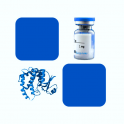
- Remove this product from my favorite's list.
- Add this product to my list of favorites.
Products
Newsletter
 |  |  |  |  |  |

Background
4-1BB is also known as CD137, tumor necrosis factor receptor superfamily member 9 (TNFRSF9), induced by lymphocyte activation (ILA), is a co-stimulatory molecule of the tumor necrosis factor (TNF) receptor superfamily. CD137 can be expressed by activated T cells, but to a larger extent on CD8 than on CD4 T cells. In addition, CD137 expression is found on dendritic cells, follicular dendritic cells, natural killer cells, granulocytes and cells of blood vessel walls at sites of inflammation. The best characterized activity of CD137 is its costimulatory activity for activated T cells. Crosslinking of CD137 enhances T cell proliferation, IL-2 secretion survival and cytolytic activity. Further, it can enhance immune activity to eliminate tumors in mice. CD137 can enhance activation-induced T cell apoptosis when triggered by engagement of the TCR/CD3 complex. In addition, 4-1BB/4-1BBL co-stimulatory pathway has been shown to augment secondary CTL responses to several viruses, and meanwhile augment anti-tumor immunity. 4-1BB thus is a promising candidate for immunotherapy of human cancer. CD137 has been shown to interact with TRAF2.
Source
Recombinant Cynomolgus / Rhesus macaque 4-1BB, His Tag (41B-C52H4) is expressed from human 293 cells (HEK293). It contains AA Leu 24 - Gln 186 (Accession # XP_005544945.1). In the region Leu 24 - Gln 186, the AA sequence of Cynomolgus and Rhesus macaque 4-1BB are homologus.
Predicted N-terminus: Leu 24
Molecular Characterization
This protein carries a polyhistidine tag at the C-terminus.
The protein has a calculated MW of 19.2 kDa. The protein migrates as 30-40 kDa under reducing (R) condition (SDS-PAGE) due to glycosylation.
Endotoxin
Less than 1.0 EU per μg by the LAL method.
Purity
>90% as determined by SDS-PAGE.
Formulation
Lyophilized from 0.22 μm filtered solution in PBS, pH7.4 with trehalose as protectant.
Reconstitution
Please see Certificate of Analysis for specific instructions.
For best performance, we strongly recommend you to follow the reconstitution protocol provided in the CoA.
Storage
For long term storage, the product should be stored at lyophilized state at -20°C or lower.
Please avoid repeated freeze-thaw cycles.
This product is stable after storage at:
-20°C to -70°C for 12 months in lyophilized state;
-70°C for 3 months under sterile conditions after reconstitution.
Bioactivity
Please refer to product data sheet.
(1) "CD276-CAR T cells and Dual-CAR T cells targeting CD276/FGFR4 promote rhabdomyosarcoma clearance in orthotopic mouse models"
Timpanaro, Piccand, Dzhumashev et al
J Exp Clin Cancer Res (2023) 42 (1), 293
(2) "Chimeric autoantibody receptor T cells deplete NMDA receptor-specific B cells"
Reincke, von Wardenburg, Homeyer et al
Cell (2023)
(3) "Differentiation of BCMA-specific induced pluripotent stem cells into CD8ab+ T cells targeting myeloma"
Bae, Kitayama, Herbert et al
Blood (2023)
Showing 1-3 of 1725 papers.
Welcome Login
Contact us
Follow us